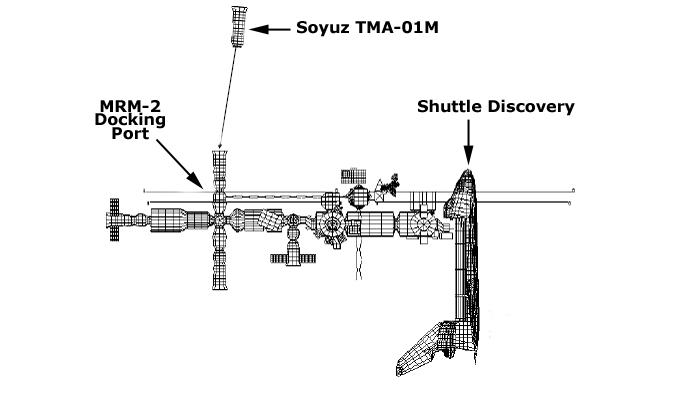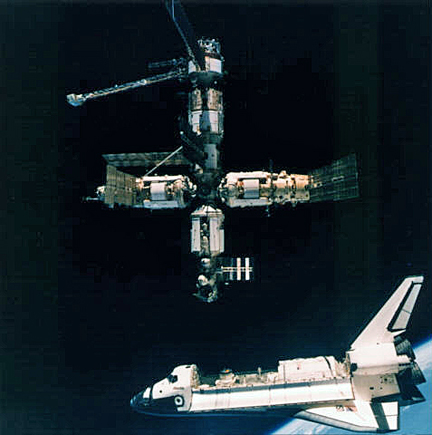NASA proposes Soyuz photo op; shuttle launch readiness reviewed (UPDATED)
Editor's note...
NASA managers, engineers and contractors met Friday for a program-level review of the shuttle Discovery's ground processing and readiness to launch Feb. 24 on a long-delayed space station assembly mission. After an all-day meeting, the team agreed to press ahead with preparations and a final executive-level fight readiness review Feb. 18.
Along with reviewing ground processing and external tank repairs, shuttle managers also are considering the possibility of staging what might be considered the ultimate photo op during Discovery's mission to deliver critical supplies and a final U.S. module to the space station.
The idea is to have a Russian Soyuz spacecraft undock so its three-man crew can photograph the station from a distance, showing the completed lab complex with the shuttle attached, along with Russian, European and Japanese cargo ships and crew capsules. Discovery's mission represents the last time a shuttle and all current types of visiting spacecraft will be present at the station before the shuttle fleet is retired later this year.
But the plan would require Russian approval and cooperation and it's not yet known if they will go along.
It is not a trivial undertaking. Anytime a manned spacecraft undocks, there is the possibility of a malfunction that could prevent a re-docking. In that case, the Soyuz and its three-man crew -- Soyuz TMA-01M commander Alexander Kaleri, Oleg Skripochka and Expedition 26 commander Scott Kelly -- would be forced to return directly to Earth, reducing the station's crew from six to three.
"This only hit people's radar at the end of last week," said one NASA manager. While video and still photos showing the completed space station with a shuttle attached would no doubt be spectacular, at least some agency insiders believe the risks outweigh the benefits. Others, seeing a chance to capture a defining image of the shuttle-station complex, are hopeful the Russians will approve.
The Russians staged a similar photo operation on July 4, 1995, when the shuttle Atlantis undocked after NASA's first linkup with the Russian Mir space station. Just before Atlantis separated, cosmonauts Anatoly Solovyev and Nikolai Budarin undocked in a Soyuz spacecraft and photographed the shuttle's departure from a distance of about 300 feet.
Just after Atlantis undocked, however, Mir's central computer shut down, apparently misinterpreting the jarring caused by the shuttle's separation as a fault. The cosmonauts successfully redocked and eventually rebooted the computer. Whether that experience might affect how the Russians view the current proposal remains to be seen.
NASA originally hoped to launch Discovery Nov. 1, but the flight was delayed because of bad weather and relatively minor technical snags. A launch attempt Nov. 5 was called off because of a gaseous hydrogen leak in a vent line attached to the ship's external tank. Then, during propellant draining operations, engineers discovered cracks in vertical rib-like stringers making up a central compartment in the huge tank.
Launch then was put on indefinite hold while engineers worked to repair the cracks and figure out what caused them in the first place. After a fueling test, extensive testing and additional inspections, NASA managers concluded the root cause was a combination of factors, including the effects of ultra-low temperature propellant, manufacturing issues and use of an aluminum-lithium alloy that was not as strong as expected.
Managers ultimately decided to install stiffeners on nearly all of the 108 stringers used in the so-called "intertank" section of the external tank. That work is complete, but tests and analysis have continued to make sure the modified tank has the required margin of safety.
In recent days, engineers have run into a variety of fresh problems with the gaseous hydrogen vent line that leaked Nov. 5, derailing Discovery's last launch attempt.
The leak was blamed on subtle alignment issues that, in the presence of low-temperature hydrogen gas, opened a leak path. Corrective actions were taken and during a fueling test Dec. 18, the fitting worked normally, without any significant leakage.
Because of trouble disconnecting the line later, technicians replaced a seal in the system this week. But during work to re-attach the vent line and rig it for launch, workers noticed unexpected movement in a component at the base of the umbilical plate that attaches the line to the side of the tank. Leak checks were successfully completed, but additional troubleshooting was planned.
In addition, a multi-blade tool called a "feeler gauge," similar to tools used to measure the gap in a spark plug, apparently came apart at the pad during work to rig the vent line fitting. Some of the tool's metal blades fell free and at least one of them hit Discovery's external tank. But a detailed photo analysis showed the damage was minor and no repairs were necessary.
In an unrelated issue, engineers preparing to service the system used to move the nozzles of the shuttle's two solid-fuel boosters heard an unexpected bang-like noise Monday. There were no obvious signs of trouble with the hardware and it's possible the sound was caused by a gust of wind slamming a door or an access panel closed on the launch pad gantry.
- Posted at 10:24 AM, 02/11/11: NASA proposes Soyuz photo op; launch readiness reviews on tap
- Updated at 04:55 PM, 02/11/11: Shuttle program readiness review concludes
- By WILLIAM HARWOOD
NASA managers, engineers and contractors met Friday for a program-level review of the shuttle Discovery's ground processing and readiness to launch Feb. 24 on a long-delayed space station assembly mission. After an all-day meeting, the team agreed to press ahead with preparations and a final executive-level fight readiness review Feb. 18.
Along with reviewing ground processing and external tank repairs, shuttle managers also are considering the possibility of staging what might be considered the ultimate photo op during Discovery's mission to deliver critical supplies and a final U.S. module to the space station.
 |
| NASA managers have asked their Russian counterparts to consider a Soyuz flyaround of the space station during Discovery's upcoming mission to photograph the the lab complex with the shuttle and the full variety of Russian, European and Japanese cargo and crew capsules attached. |
The idea is to have a Russian Soyuz spacecraft undock so its three-man crew can photograph the station from a distance, showing the completed lab complex with the shuttle attached, along with Russian, European and Japanese cargo ships and crew capsules. Discovery's mission represents the last time a shuttle and all current types of visiting spacecraft will be present at the station before the shuttle fleet is retired later this year.
But the plan would require Russian approval and cooperation and it's not yet known if they will go along.
It is not a trivial undertaking. Anytime a manned spacecraft undocks, there is the possibility of a malfunction that could prevent a re-docking. In that case, the Soyuz and its three-man crew -- Soyuz TMA-01M commander Alexander Kaleri, Oleg Skripochka and Expedition 26 commander Scott Kelly -- would be forced to return directly to Earth, reducing the station's crew from six to three.
"This only hit people's radar at the end of last week," said one NASA manager. While video and still photos showing the completed space station with a shuttle attached would no doubt be spectacular, at least some agency insiders believe the risks outweigh the benefits. Others, seeing a chance to capture a defining image of the shuttle-station complex, are hopeful the Russians will approve.
 |
| During the first shuttle visit to the Russian Mir space station in 1995, the crew of a Russian Soyuz spacecraft undocked and photographed the departure of the shuttle Atlantis. (Credit: NASA) |
Just after Atlantis undocked, however, Mir's central computer shut down, apparently misinterpreting the jarring caused by the shuttle's separation as a fault. The cosmonauts successfully redocked and eventually rebooted the computer. Whether that experience might affect how the Russians view the current proposal remains to be seen.
NASA originally hoped to launch Discovery Nov. 1, but the flight was delayed because of bad weather and relatively minor technical snags. A launch attempt Nov. 5 was called off because of a gaseous hydrogen leak in a vent line attached to the ship's external tank. Then, during propellant draining operations, engineers discovered cracks in vertical rib-like stringers making up a central compartment in the huge tank.
Launch then was put on indefinite hold while engineers worked to repair the cracks and figure out what caused them in the first place. After a fueling test, extensive testing and additional inspections, NASA managers concluded the root cause was a combination of factors, including the effects of ultra-low temperature propellant, manufacturing issues and use of an aluminum-lithium alloy that was not as strong as expected.
Managers ultimately decided to install stiffeners on nearly all of the 108 stringers used in the so-called "intertank" section of the external tank. That work is complete, but tests and analysis have continued to make sure the modified tank has the required margin of safety.
In recent days, engineers have run into a variety of fresh problems with the gaseous hydrogen vent line that leaked Nov. 5, derailing Discovery's last launch attempt.
The leak was blamed on subtle alignment issues that, in the presence of low-temperature hydrogen gas, opened a leak path. Corrective actions were taken and during a fueling test Dec. 18, the fitting worked normally, without any significant leakage.
Because of trouble disconnecting the line later, technicians replaced a seal in the system this week. But during work to re-attach the vent line and rig it for launch, workers noticed unexpected movement in a component at the base of the umbilical plate that attaches the line to the side of the tank. Leak checks were successfully completed, but additional troubleshooting was planned.
In addition, a multi-blade tool called a "feeler gauge," similar to tools used to measure the gap in a spark plug, apparently came apart at the pad during work to rig the vent line fitting. Some of the tool's metal blades fell free and at least one of them hit Discovery's external tank. But a detailed photo analysis showed the damage was minor and no repairs were necessary.
In an unrelated issue, engineers preparing to service the system used to move the nozzles of the shuttle's two solid-fuel boosters heard an unexpected bang-like noise Monday. There were no obvious signs of trouble with the hardware and it's possible the sound was caused by a gust of wind slamming a door or an access panel closed on the launch pad gantry.